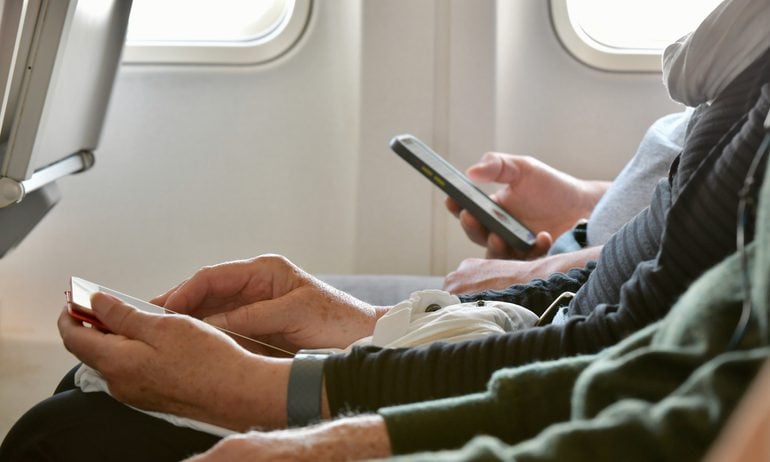Is There Wi-Fi on Planes That’s Actually Good? How to Know
Reviewing coverage maps and researching the provider your airline uses can give you an idea of Wi-Fi quality.

Many or all of the products on this page are from partners who compensate us when you click to or take an action on their website, but this does not influence our evaluations or ratings. Our opinions are our own.
Concerning Wi-Fi on flights, it sometimes feels like you're rolling the dice every time you fly. Is there Wi-Fi on the plane? If so, will the airplane Wi-Fi work or be super slow? Also, is it safe to tell colleagues that you're "online and available" for work during a flight?
Even though most airlines offer Wi-Fi on most continental routes in the United States, sometimes it can be a bit spotty (to put it nicely). So why is it that some in-flight Wi-Fi connections are excellent — and others are terrible?
Let's take a look at the different types of airline Wi-Fi, which is best and how to figure out what you'll have on your next flight.
The 3 main types of Wi-Fi on planes
According to the Wi-Fi survey site NetSpot, you'll find three main Wi-Fi types on planes.
Air-to-ground, or ATG
The first is air-to-ground, which involves antennas installed on the belly of the airplane. These antennas pick up signals from land-based cell towers.
This type means you shouldn't have dropped coverage when traveling over places with good cell phone service. But in remote locations or over large bodies of water? That's when you'll start to encounter issues.
Satellite
The other type of Wi-Fi involves using the plane's antennas to communicate with satellites to provide Wi-Fi to passengers. The internet speed depends on which frequency the Wi-Fi is using:
Ku-band is a lower radio frequency. Planes equipped with Gogo internet, for example, use this frequency.
Ka-band is a higher radio frequency. Planes that use this frequency for data transfer have faster internet speeds.
JetBlue Airways, for example, uses a Ka-band satellite antenna to power the internet and live TV on board its A220 aircraft, according to JetBlue's internet provider, Viasat.
Bonus Wi-Fi type: Starlink
There's an up-and-coming player in the realm of in-flight Wi-Fi to help you sneak in some work or maximize airline entertainment. SpaceX's Starlink launched on select Hawaiian Airlines aircraft in 2024.
Starlink aims to offer ultra high-speed Wi-Fi on flights. Hawaiian is the first airline to ink a deal for this internet, whose speeds are only increasing as the company continues launching satellites.
Not all plane Wi-Fi is equal
We've talked about the different types of Wi-Fi on planes, but not their speeds. This is important; you don't want to pay for an in-flight internet package only to find out that the Wi-Fi is barely usable.
Air-to-ground is the slowest of the three main types of Wi-Fi and will allow you to access things like emails and social networks. Ku-band is much faster — but the speed of your service will depend on how many aircraft are currently using each satellite.
Ka-band, meanwhile, is the fastest of the three most common types, but also the most limited in scope.
According to internet speed test provider Ookla, Starlink has improved its internet speed by 38% in the U.S. over the last year. This bodes well for any airline jumping on the Starlink bandwagon.
How to determine if your next flight's Wi-Fi will be good
If you want to know ahead of time if you'll have good Wi-Fi, here are a couple of tips to understand what you're facing.
Is Wi-Fi offered, and if so, will it work for you?
First, ensure the aircraft you're flying will even offer Wi-Fi. Reviewing its policies can help determine if it will meet your in-flight needs.
For instance, Southwest Airlines blocks access to specific high-bandwidth applications, websites and video conferencing services, including Zoom and Microsoft Teams. That means you probably won't make that midflight video conference call.
Will you be covered?
Take a look at the Wi-Fi coverage map of the airline that you're flying. A quick online search can give you details about your airline of choice and its Wi-Fi offerings.
United Airlines, for example, works with four different Wi-Fi providers: Gogo, Panasonic, Thales and Viasat. It provides a map for each service, letting you know where you'll have Wi-Fi and where it'll be spotty. The site also lets you know which aircraft is equipped with which service.
How fast is in-flight Wi-Fi?
Research what type of Wi-Fi the airline offers to better predict what internet speeds you can expect. As a reminder, the most common Wi-Fi types are ATG, Ku-band and Ka-Band (listed from slowest to fastest).
Delta Air Lines, for instance, offers a simple coverage map, letting travelers know which aircraft rely on which types of satellites.
This research might sound like a lot of work, but it can be worth it when you're spending 12 hours in the air and stressing about responding to an urgent email.
Consider the cost
The good news is that Wi-Fi on planes is not only getting better but less expensive as well. You might even get it for free. For instance, JetBlue offers free "Fly-Fi" on all of its flights, and certain airlines offer elite members free Wi-Fi.
Here are the major U.S. airlines and the cost of messaging and Wi-Fi:
Airline | Free messaging | In-flight Wi-Fi cost |
|---|---|---|
American Airlines | No. | Varies by flight. |
Alaska Airlines | Yes. | $8 on most aircraft. |
Delta Air Lines | Yes. | Varies by flight, but free to all Delta SkyMiles members regardless of status (or lack of status). |
JetBlue Airways | Yes. | Free. |
Southwest Airlines | Yes. | $8 per device, per flight (free for Business Select passengers). |
United Airlines | Yes. | $8 for United MileagePlus members (it’s free to join), $10 for non-members. |
Many airlines offer free messaging (without paying for in-flight Wi-Fi) if you use a messaging app like iMessage or WhatsApp, as well as free movies, TV shows and music. However, having in-flight Wi-Fi will give you access to more websites than what's available complimentary to passengers.
Look to your cell service provider
Some cell phone plans also give free in-flight Wi-Fi to customers. For example, T-Mobile customers on Go5G Next and Go5G Plus Plans get unlimited full-flight Wi-Fi, texting and streaming. Meanwhile, with a T-Mobile Go5G Plan, customers get unlimited texting. From there, they can choose four full flights a year with Wi-Fi & streaming, and then one hour in-flight Wi-Fi & streaming on additional flights.
If you want Wi-Fi on your flight
Plenty of airlines offer Wi-Fi on flights, but not all service is created equal. Thanks to advancements in technology, we're seeing better speeds — but plenty of aircraft still rely on outdated equipment, so you'll be waiting a while for that Facebook feed to load.
If you're wondering whether the Wi-Fi for your upcoming travel will meet your needs, you can look at the coverage map for your airline. Otherwise, cross your fingers, spend a few dollars on the internet package and hope for the best.
Chase Sapphire Preferred® Card
Travel
Dining
🔥 Huge highest-ever bonus on NerdWallet's 2025 Best All-Purpose Travel Rewards Card is back. Don't miss your rare chance to: Earn 100,000 points when you spend $5,000 on purchases in the first three months. That's worth at least $1,250 toward travel booked through Chase.


